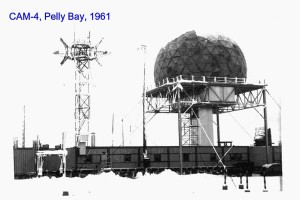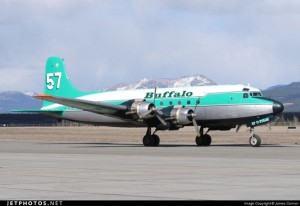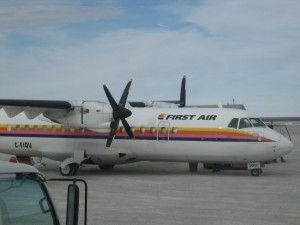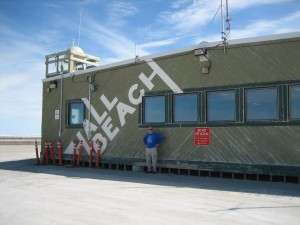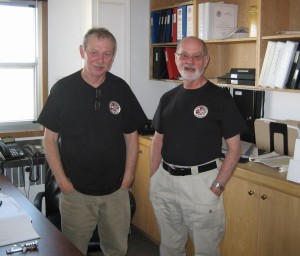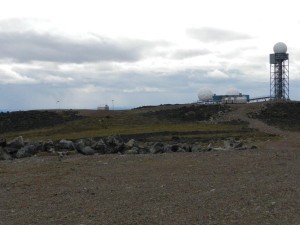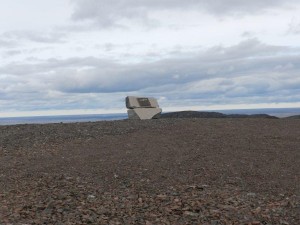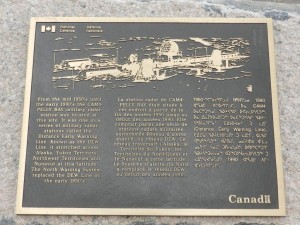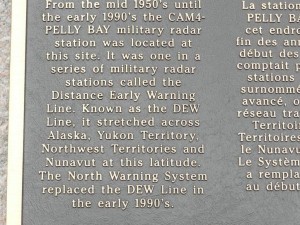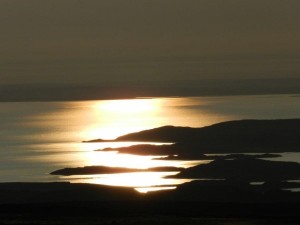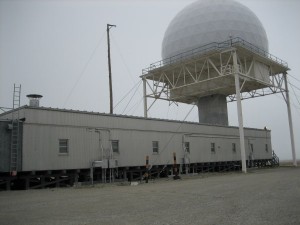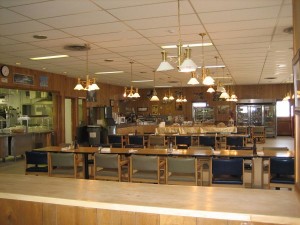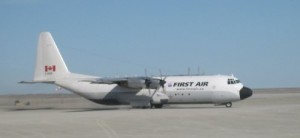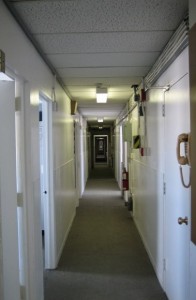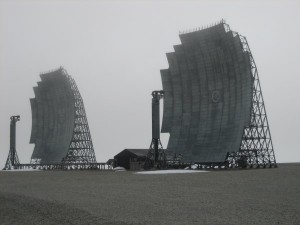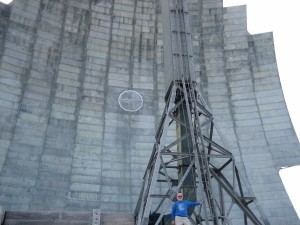Return to the DEWLine – Trip Report
On July 29, 1960, 19 year old Brian (Simon) Jeffrey stepped off DC-4 CF-IQM at Hall Beach NWT, FOX Main, to begin a three year career as a radar technician (Radician) in the FOX Sector of the Distant Early Warning Radar Line (DEWLine).
Fifty-two years later, July 2012, 71 year old Brian Jeffrey stepped off ATR-42 C-FIQU to return to Hall Beach NU, still FOX Main, to fulfil his dream of physically strolling down memory lane.
The youngest Radician to be sent to the DEWLIne in 1960, Brian is probably the oldest DEWLiner to make a return visit.
Here then, is the trip report of Brian’s dream trek back to Hall Beach, 52 years later.
The Dream
It started innocently enough, a simple dream to return to FOX Main (Hall Beach NU), the place where I had my 20th birthday, 50 years after the fact. I would be 70 in 2010.
It was 2009 when the dream started. That gave me less than a year to make it happen. The DEWLine had morphed into the North Warning System (NWS) and I had no contacts,
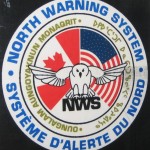
The North Warning System replaced the DEWLine in the late 1990’s.
at any level, within the Nasittuq Corporation who manages the NWS or the Government to make this thing happen. By 2012, the dream had all but died, or so I thought.
The dream came about because for the past few years I had been in regular correspondence with fellow DEWLiners Paul Kelley in Wales UK and Lyall Lalonde in Winnipeg. Lyall and I first met at CAM-D in 1960 when he was the sector mechanic and I was the station radician. Our paths crossed from time to time while we were on the Line.
On the other hand, Paul and I were both radicians at FOX Main around the same time but neither of us remembers the other and we didn’t connect until 2005 or so. Since then, we’ve been in fairly constant communications while he was documenting his time on the Line. He has an incredibly detailed tale to tell.
It was because of these contacts that I began to get the urge to “go home” again. In fact, my first home-away-from-home was CAM-4 Pelly Bay. Until I arrived at CAM-4 in August of 1960, I had lived at home with my mother. I was now on my own and out of the nest for the first time.
Rekindled Dream
Over the years, various people would stumble over my DEWLine.ca or my VE3UU.com websites and contact me with questions and/or their stories of the DEWLine and life in the Arctic.
One such person was Mark Pimlott. Mark lives and works in Igloolik NU, and has for many years. I’m not exactly sure how we first connected but Mark has been kind enough to send me stuff from time to time. It was one of these pieces of ‘stuff’ that rekindled the dream and was instrumental in making it happen.
On May 31, 2012, Mark sent me an email with an attachment showing some interpretative panels that were proposed for installation at Hall Beach. The panel included several quotes from Paul Kelley so I forwarded it on to Paul for his reading pleasure.
Then, one day later, I received a second email from Mark containing yet another PDF (DEWPanels3.pdf), this one not only containing quotes by me but several pictures from my web site including photos of yours truly as a young Radician. In his email Mark asked if the Nunavut Parks department had asked for my permission to use my stuff on their interpretive panels. They hadn’t.
The fact that they hadn’t sought my permission didn’t bother me as I was delighted that someone found it interesting enough to use. However, the fact that they had used my material without asking permission opened the door for me to seek their assistance in realizing my dream of visiting Hall Beach.
I sent off an email to the minister in charge of the Nunavut Parks department in an attempt to make him feel guilty enough to bring me up North. While it didn’t work, the gentleman who replied, Cameron Delong, copied Jessica Hallam of the Nassituq Corporation who offered to see what could be done about arranging for a visit to FOX Main, Hall Beach NU facility. The Nassituq Corporation is the organization that manages the Northern Warning System.

The Stars Align
Jessica contacted me on June 13 and let me know that she was the person who arranged things like this and that, “I have never dealt with a request of this nature, but I’ll do my best.”
Complicating my situation was the fact that I had been diagnosed with an aggressive form of kidney cancer in my right kidney and was slated to go into the hospital on July 17 to have the damn thing removed. This severely limited my window of opportunity in that if this visit didn’t happen soon, it wasn’t going to happen at all for me.
On June 18, Jessica had received approval from both the Nassituq Corporation and the Canadian Government for me to visit Hall Beach. The only dates available were July 2-4. As an added bonus, the Nassituq Corporation would provide accommodations, rations, and local transportation while I was at Hall Beach.
All I had to do was arrange my own transportation north which I did within minutes of receiving Jessica’s email. I would leave Ottawa via FirstAir on July 1st, overnight in Iqaluit NU, and carry on to Hall Beach on July 2nd.
Like a Child on Christmas Eve
To say that I was excited about the trip is an understatement. I couldn’t have been more excited. I was like a small child on Christmas Eve, full of anticipation and expectations. Was Santa going to be good to me? Will I be allowed into the Electronic Modules where I spent most of my DEWLine work life? What do the buildings look like now? How might they have changed? What has 52 years done to the appearance of the facilities? Is the Emergency Radio room where I operated as VE8SK still there? Might I get to operate the station one last time?
The Journey of a Lifetime (for Me)
For whatever reason, I knew that this trip was going to be a big thing in my life and I was sharp enough to keep a log or diary of the journey. What follows is an edited version of that diary with some additional observations.
Day 1: July 1 2012, Canada Day.
The Journey Begins
My wife Lorraine dropped me off at the airport in lots of time. I was so pumped that I would have slept at the airport overnight if there had been any chance of missing this flight.
As I mentioned, I was like a little kid at Christmas except, instead of waiting for Santa Claus to come down from the north, I was going north to beat him to the punch.
First Stop: Iqaluit
The trip north on FirstAir was a hell of a lot shorter and more comfortable than the one I took 52 years ago. About three hours to Iqaluit (aka Frobisher Bay in 1963) by 737-200 rather than six to seven hours in Nordair’s DC-4, CF-IQM. Interestingly enough, CF-IQM is still flying and now wears the livery of Buffalo Airways. The old workhorse lives on!
The flight was surprisingly full, about two-thirds, as there were a large number of students on an Arctic adventure of some sort. The FirstAir cabin service was a throwback to earlier days when cabin crews were pleasant and service oriented. The FirstAir cabin crew couldn’t do enough for the passengers and their warm chocolate chip cookies are to die for.
We arrived around noon and after a three minute, $6 cab drive, I arrived at the Capital Suites Inn. I got here in time to catch the tail end of the Canada Day parade and decided to take a walking tour around town, including a trek to the highest point of town where I took pictures of the entire town.
By 1:30 I had exhausted both my legs and the sights. I tried to have a mid-afternoon nap but my mind wouldn’t shut off so I went off on another walking adventure this time bypassing the Tim Horton’s coffee shop and on to the local museum and the visitor center, both of which were open and quite interesting. Timmies was closed so I couldn’t compare prices although a whole watermelon in the local supermarket was advertised as being “on sale” for $14 and pineapples were $7 ea. I can only imagine what a coffee and muffin must have cost at Tim Horton’s.
I’m discovering an interesting phenomenon, it seems that the DEWLine has all but disappeared from view (or interest) from this area. The few people with whom I’ve had a chance to share my quest were polite but basically uninterested. I supposed I shouldn’t be too surprised as these days people seem to be quite self-absorbed anyways. I suspect it will be different in Hall Beach as the community lives in the shadows of a DEWLine main station, FOX Main.
I had Arctic char for supper at a nearby restaurant and, as was promised by the desk clerk at my hotel, the food was good and the service was poor. My other choices were a hotel where the service was good and the food lousy, yet another where both the food and service were good but the prices were very high, and finally, a place where the food, service, and prices were good but the walk to get to it was long.
Tomorrow I need to get to the airport by 6:30 to catch my 7:30 flight to Igloolik and Hall Beach. I hope to get off the plane at Igloolik to shake Mark Pimlott’s hand as he’s the guy who started this by sending me the information on the proposed Hall Beach interpretive panel that had my pictures on it.
Day 2: July 2, 2012
On to Hall Beach
The plane should have left 20 minutes ago but the fog is very bad and I have no idea when we will leave nor is anyone saying anything as yet. The departures board still shows the flight as being ‘on-time.’
Seeing as I was awake early, I decided to walk over to the airport from the hotel rather than make a further investment in the Iqaluit economy by taking a $6 cab ride. The walk over took about 10 minutes in the quiet morning fog. I was the first passenger at the terminal this morning. There are probably about 30 of us here now waiting for the fog to lift. I overheard one person saying that they are on their fourth day here waiting for good weather at their destination. I know the weather at my destination is good; it’s the weather at my departure point, Iqaluit, that’s the problem.

Arriving at Hall Beach
We finally took off at 9:00 am but were unable to land in Igloolik due to poor weather at that site. The entire flight of two hours was eventless as we were above the clouds. My seatmate was a six to seven year old aboriginal boy who, like every child of that age, was a bundle of pent-up perpetual motion. I think I have bruises on my right leg from his continual kicking of it. He was lucky to get off the plane unharmed!
The plane was a French/Italian ATR-42 and was half cargo and half passenger (20 of us including the obligatory nursing aboriginal!). Cabin service included a plastic version of the paper box lunch I had for my first trip 52 years ago.
Here’s another quirk of fate. The aircraft registration for my first trip north was CF-IQM. The registration of today’s aircraft was C-FIQU. Go figure.
I didn’t realize that we had missed landing at Igloolik until we began landing and I saw the radome and troposcatter antennas. I thought it was a bit strange until I realized that we were landing at Hall Beach, and not Igloolik.
The old hanger is still there but decommissioned and is now used for storage. Unlike in 1960, there is now an actual terminal building in place if the USAF blue school bus that we used to deplane into. I was met at the ‘airport’ by the station maintenance person, Gerald Walsh, who brought me up to the main building where I met Rick Chaulk, the site manager, otherwise known as “God.”
Rick is a charming Newfoundlander who instantly made me feel welcome and who will be giving me a tour after lunch.
First Look Around (in 52 years!)
I had an incredible afternoon. Rick Chaulk, the site manager couldn’t have been more accommodating and pleasant. It’s almost like having a visitor is a welcomed diversion from their daily grind.
Unfortunately, all three electronic maintenance technicians are off site doing preventative maintenance at the various sites under FOX Main’s control. Their responsibility runs from
CAM 4, Pelly Bay, on the west, now CAM 4A as the original site has been razed, to FOX CA which replaced FOX C, to the east. There are Long Range Radars (LRR’s) at CAM 3, FOX Main, and FOX 3 with Short Range Radars (SRR’s) in between at CAM D, CAM 4A, CAM 5A, CAM-FA, FOX 1, FOX A, FOX 2, FOX B, and FOX CA.
Interesting side note, whereas in our day we had six to eight technical people per site, or about 50 technicians for the entire sector (seven sites), now the sector only has three technicians. They fly them out by helicopter whenever something goes wrong. Almost all the sites are totally unmanned and remotely monitored in North Bay and at FOX Main. No more daily lateral flights, just helicopter flights on an as needed basis.
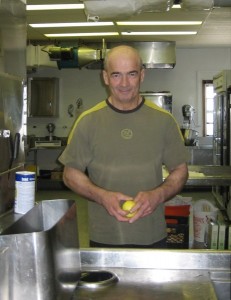
Marion Rocko was extremely accommodating and helpful in my quest to see as much as possible during my brief stay.
Marion Rocko, the site’s facilities manager, took me on a driving tour around the site and into the community of Hall Beach which is about six kilometres north of the main site. It’s a bit sad to see the conditions of the community. There is little to no sign of community pride. Things are left everywhere. Buildings are in disrepair or derelict. What new buildings there were looked like they were on their way to a similar state of disrepair.
Marion was kind enough to take a number of photos with me in them so at least I’ll have some proof of actually being here.
Marion is the gentleman in charge of the power generation plant and took me on a tour of their power plant. If I remember correctly, they have six generators, three of which are about 230Kw and 3 around 177Kw. The remote sites all have three Lister diesel generators. Only one generator is required to power the site. Should one generator fail, the second one immediately comes alive and an alarm is sent. The third generator is there in case the second one has a problem. Triple redundancy. As the remote sites are unmanned, they don’t need to have the lights on until someone shows up to do work so the power requirements are modest.
Marion also drove up to the top of the berm where all the toxic waste had to be disposed of at a horrendous cost. There is a plaque on it. Apparently there is a fabulous plaque at the location where CAM 4 used to be. The site has been wiped off the face of the earth and the site now stands as a model of cleaning up a technological mess and returning the land to pristine condition.
The news of the demise of CAM 4 saddened me as CAM 4 (Pelly Bay) was my first real home-away-from-home. Now it is no more. It felt like I had lost a bit of personal history.
Here are some photo`s of CAM-4 today. My thanks to Marion Rocko for taking the time to get these to me as I would never have been able to go to CAM-4 myself.
Accommodations
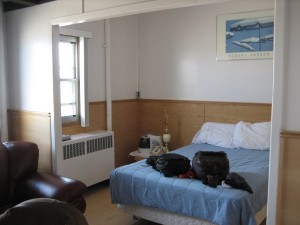
The VIP bedroom is twice the size of my original one as they have combined two rooms into one.
During the latter part of the afternoon I had free run of the buildings so I went around taking photos of everything. I’m in a VIP accommodation. What they have done is taken a number of the room pairs and knocked out the adjoining wall to double the size of the room. So basically,
my current room is twice the size of my former room in 1963. The arrangement gives you a double bed instead of a single, and a sitting room with a very comfortable easy chair. Many of the rooms have TV service as well.
Fortunately, I’m on a northerly facing bedroom so the 24 hours daylight won’t be too bad. If I’m up, I may go out around midnight just to take a photo.
Electronic Modules
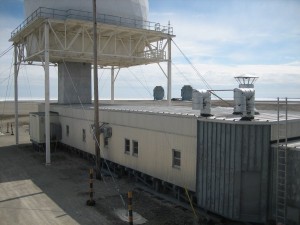
The Electronic Modules. Notice the expansion on the radar module to accommodate the FPS-117.
The last thing that I did this afternoon was to have a tour of the “Operations Area” in the former Electronics modules. As you recall, this was one of my hidden hopes. Rick asked if I still held a ‘secret’ clearance and I assured him that I did as I’ve done nothing to lose it and it doesn’t have to be renewed.
As one might expect, all the rooms have been repurposed and none of the original equipment, or even signs of the original equipment, are there. The Console Room where every radician, and in later days, console operators, would have spent at least four hours a day, is now one large room instead of two and all remnants of the communication centre gear and console equipment have disappeared.
As the Operations Area is still considered confidential, I won’t be outlining what I saw in each of the rooms. If you’re a former DEWLiner and you’re curious, contact me by email.
As you might imagine, it was quite a thrill for me to revisit the area where I spent so much of my time as a radician during 1960-63. Probably only another DEWLiner would understand how I felt.
I asked about the Emergency Radio Room which originally contained amateur radio equipment and, as expected, it is long gone as is the need for such equipment. Satellite and telephones have replaced the need for HF radio equipment.
End of a Long day
The canteen, such as it is, was open just prior to supper so I purchased the obligatory souvenirs to take home with me.
Supper was good but not great. There was lots of it though and more desserts than you can shake a stick at. It wouldn’t take long to put on extra weight if you weren’t careful. You can go to the dining area at any time, day or night, for a bowl full of ice cream, piece of pie or cake, and the coffee’s always on. The coffee isn’t always as fresh as one might want but it’s always there.
After supper I met one of the site’s three meteorological (weather) people in the recreation area. He was a chatty fellow and pretty well filled me in on what’s what in the met department.
The old meteorological buildings are still there but only used for storage at this point as the Met people now work out of the airport terminal building. The Met people are no longer government employees but work for a private, for-profit company that provides the service under contract. Each of the three people provide all three services; upper air atmospheric measurements, weather observations, and handle air/ground radio communications for the airport.
Of the three met people, only two are on the site at any given time. The two that are here work one long day (15 hours) on and one day off on a rotational basis. They spend eight weeks up here and then go south for four weeks. The eight weeks here and then four weeks down south schedule seem to be the standard rotation for many people on the site. This is far different from earlier times when you spent six months, or more here, and two weeks off.
One other interesting phenomenon – the site is basically empty. Apart from the five RCMP officers who arrived to investigate a local stabbing, there were probably no more than 10-15 people around. I had the recreation module pretty well to myself for most of the evening. It seemed a bit surreal to be lounging in an easy chair, watching television, 1800 miles north of home.
Day 3: July 3, 2012.
First Full Day
Despite closing what curtains I have on the windows of my north westerly facing bedroom, the midnight sun still lit up my room making it difficult to sleep. Part of the difficulty is my continued excitement at just being here.
I stayed up until just after 11pm as I wanted to get a shot of the midnight sun. Even a photo doesn’t do the phenomenon justice; you have to experience it in person for the full effect.
Upon awakening from what little sleep I did get I discovered two problems. One, the fog outside made it difficult to see from one end of the module train to the other and two, I neglected to bring a towel with me and none are provided at Hotel FOX Main. No shower for me! Drying oneself with paper towels presents an interesting challenge.
The fog is going to put a crimp on my sightseeing adventures unless it burns off. Even more importantly, it could put a big crimp in tomorrow’s travel plans as I’m due to return south.
After an excellent breakfast I attended the 8AM station briefing where the day’s activities were outlined. With the exception of one sick person, everyone was there including the site maintenance person and cook, for a total of eight people. Eight people on a site than in earlier times held 80 or more. Eerie. I suspect that there may be another half dozen workers around, probably seasonal folks, as the occasional strange face pops up from time to time.
Weather permitting we’re expecting a FirstAir Hercules aircraft in later today for an airlift of material to Fox 3. That’s expected to take several days. Much of the cargo will be POL (fuel for the generators).
I’m not sure what today will bring. With the fog being as thick as it is it will be unsafe to wander around the site as once you are out of sight of landmarks, you would have no idea as to where you are and which direction you should go. Let’s hope it burns off before mid-day.
I was chatting with Marion this morning before the station briefing and he was explaining the political situation to me. Nasittuq’s contract has expired and they are operating on an extension while the project goes out to tender. Both Raytheon and SNC-Lavalin want to bid on the contract so Nasittuq has been cutting costs where they can in order to hold on to the contract. As one might expect, this process has had an impact on people’s morale.
Unlike the early years, the place is unionized. People have to keep time sheets and are paid overtime when appropriate. The battle to keep costs low has meant that preventative maintenance is kept to a minimum and the emphasis is on corrective maintenance.
On a more pleasant note, people have been very accommodating and while I’m obviously an outsider, I’ve been made to feel very welcome.
I suspect that by tomorrow morning I will have seen everything I wanted to see and more and I’ll be ready to come home with a brain full of memories.
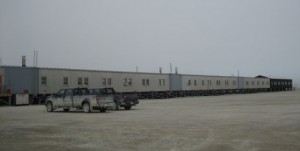
Exploring the Module Trains
As the site is still enclosed in the fog, I decided to explore the part of the B-train that contained the former power generators. As I remember the area, there was a movie area just before the power generator modules. As you leave the inter-module train overpass and turn to the right, that immediate area is now the site admin offices. These were previously located in A-train modules. As you go down the corridor past the offices and where the old movie area was, you go into where the generators were located. You can see the change of flooring from wood to concrete. These modules now contain an extensive set of exercise equipment, weights, treadmills, punching bag, and various forms of personal torture devices known as exercise machines.
As you go even further deeper into this area there is an entrance way to the newly added waste-water recycling module that is located aside the end of the module train. I was given a tour of the equipment by Rick.
I must point out that I had never been in this part of the module train in earlier times. Only the station mechanics would have been allowed in there.
Going even further into this area you come across an enclosed ventilated “smoker’s lounge” that contains a bunch of easy chairs, large television, fake fireplace from the old military officer’s lounge of years ago, a big bar fridge, and sundry supplies for your recreational pleasure.
Finally the last modules contain some equipment that I didn’t recognize but seemed to have to do with water. Oh yes, there is also a sauna in this area as well. All the comforts of home… well sort of.
As for being the ‘only’ visitor, I’m not sure I’m the only one but I know that it is a rarity. Rick was contacted before I received my permission and asked if it was okay for me to come. Fortunately for me, he said yes. It seems that the site manager has the last word, or at least a say in who ‘visits.’
By 11 AM the fog is still showing no sign of lifting any time soon which makes the time go on forever. I took my video camera and did a stroll down most of the interiors of the A and B-train as well as the dining area.
The weather may also play havoc with the arrival of the FirstAir Hercules. We’ll see. Having explored most of the inside of the building, I’m passing some time watching TV (would you believe?). I still hope to visit the met office if possible.
Exploring Outside
The fog lifted enough for me to go exploring and it’s now official. I’ve now done more walking around this site in the last day and a half than I did during the three years I was in and out of this place in the early 60s! I never walked to or from the airport back then. I did it twice today and may do it one more time if the Hercules that is due in here in about an hour actually arrives.
The fog has been in and out all day. At one point it appeared to have generally cleared up so I walked out to the two large tropo antennas with the plan of climbing to the top to take a picture of the site. By the time I got there, the fog had rolled in again and you couldn’t see the site from the antennas at all.
I also decided that climbing the antenna would be folly, so I took a pass on that part of the adventure activities.
While on my first trip to the airfield, I stopped off at the old/new met building. (Old because it isn’t used anymore and ‘new’ because it wasn’t there in 1963.) Imagine my surprise when I found the door open and an even greater surprise when I found someone in it. It was the off-duty met guy who was using the building as a smoke room and a place to do some paper work. He showed me around the abandoned building as well as the hydrogen building where they still launch the weather balloons twice a day at 7:15am and 7:15pm along with another 1100 sites worldwide.
I trooped back to the airport and visited the resident met manager and gave him a thumb drive containing pictures from the old met station in 1963. I tried to use the thumb drive to bribe him to arrange for good weather for tomorrow. I’m not sure it worked. We’ll see tomorrow.
Everything in the met office is automated except the visual observations. No more Stevenson screens with their wet and dry bulb thermometers. Progress.
I believe I just heard the Hercules aircraft land or maybe do a missed approach. Lots of noise. It appears that the weather at the approach end of the runway was good enough for the aircraft to land.
Day 4: July 4, 2012.
Time to Leave (Again)
The weather at Hall Beach is bright and sunny, but then it’s always sunny at this time of the year. You just can’t always see it. If the weather in Iqaluit is good then the chances of leaving today are very good.
For me, it has been an incredible and powerful journey. So powerful in fact that my eyes are watering at the thought of leaving the Arctic for the very last time. Hell, I never thought I’ve have a second opportunity to leave here for the ‘last’ time.
The pace of the last two days has been such that I’ve truly been able to recapture the feelings I had during the first stay 50 some odd years ago. I’ve fit right into the pace and pulse of the station and I’ve found myself bored from time to time. Certainly the recreational activities are much better and it was a bit surreal to sit in the recreation module and watch TV much like I might do at home. It’s even odder when I realize that some of the people have their own TVs in their rooms.
There is no doubt that the more humane work schedule of eight weeks on site and four weeks down south, coupled with the double-sized rooms’ makes life up here much more endurable.
I have been able to identify one of the major benefits of this trip for me and that is that it has removed the wonder that I’ve had about this place, without really realizing I had it. Hadn’t I made this trip, I would have always wondered about this place and what was becoming of it. Now I know.
The overall plan for the area is to maintain the buildings and facilities until 2020. Although the buildings are in surprisingly good condition, unless they do something beyond normal maintenance, that is all they can reasonably expect.
I’ve crawled and walked over every inch of the place over the past few days and there isn’t much more for me to explore. With the possible exception of a former DEWLiner, few people would ever understand why such a journey would be so meaningful to me.
Final Observations
As one might expect, these are different times, 52 years of difference. Attitudes are different. There is a sense of cheerlessness here now. It’s not that everyone was walking around grumbling, it was more a lack of laughter, a lack of cheer. People were doing their jobs and doing them willingly and with dedication, but they are just that, jobs. In our day, and more importantly, our times, there was a sense that we were part of something bigger, important, and critical. Hell, we were part of the Cold War!
I also believe that the eight-in four-out schedule doesn’t foster the same kinship that a bunch of people develop when stuck in an isolated location for six to eight months does, particularly when you are truly out of touch with ‘home.’ Now, access to television, the Internet, daily commercial flights, and better communications have totally removed the sense of isolation.
Inuit Wisdom
While I was waiting at the airport for the flight home, one of the site Inuit asked if I was the “Old DEWLiner” who was visiting. (Apparently the word got around.) After assuring him that I didn’t know his father or cousin who used to work on the site in earlier years, we got to speculating about how long the site, and the jobs, might be around.
He suggested that maybe someone should start another Cold War. Interesting thought!
Southward Bound
It been forty-nine years since I last left Hall Beach and now I’m leaving it for the last time. It has been an incredible trek down memory lane for me and one that I will never forget.
I hope you enjoyed taking the nostalgic journey with me.
Footnote: I was able to combine the video footage and some still shots into a video of the trip titled, “Hall Beach: Fifty Years Later, An Old Dewliner’s Pilgrimage.”
You can watch the video below.
If the video isn’t working, try this link.

